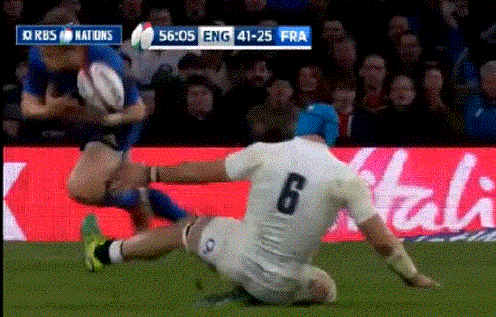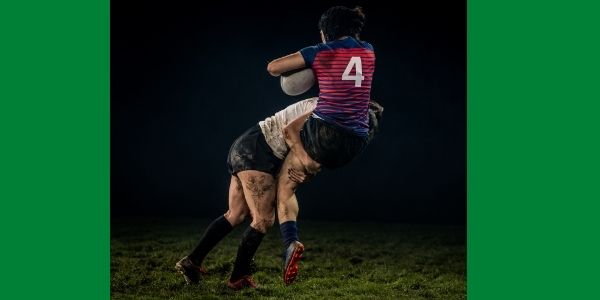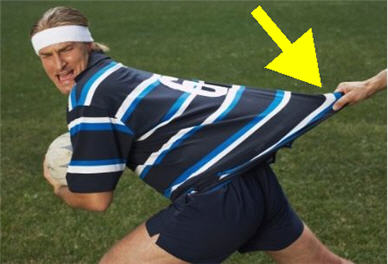Everybody knows what a classic rugby tackle looks like. It’s how cops bring down the crooks they’re chasing in the movies.
But there are plenty of different ways to tackle an opponent on a rugby field. Some ways are barely legal, and others will bring a red card and a lengthy ban from the sport.
The laws of the game have changed, and some tackles you’ll see in footage of old matches are simply not allowed anymore.
This article runs through the good, the bad, and the ugly of tackles in rugby. But I’ll do it in reverse order, starting with what is strictly illegal.
The Worst Kind Of Tackle In Rugby: Tripping
Later, I’ll show you examples of players being taken out in the air in ways that’ll make you put your hands over your eyes.
So, you may be surprised when I nominate tripping as the worst kind of tackle in rugby.
I’m not quite sure what it says about rugby culture that tripping is considered worse than a mistimed high tackle around the neck.
But they’re right up there with biting and eye-gouging in terms of disapproval from the sidelines.
Examples of tripping
Here’s a slightly blurry still as an example fro a Six Nations match between England and France. The flanker (James Haskell) sticks out a leg and trips the winger (Jules Plisson).

To be fair to Haskell, his action wasn’t deliberate. You can watch video footage in our article on whether you can trip in rugby.
That article also has one of the dumbest examples of a foul tackle that I’ve ever seen in a game. It’s almost a flying kick. It has to be seen to be believed!
Illegal Tackles In Rugby
The basic rule of tackling in rugby is that the player being tackled must be in possession of the ball.
Late and early tackles
That may seem easy for the defender to figure out.
But what if the attacking player passes the ball as the defender is closing in? What if the player drops the ball from their hands to kick it just as the defender launches into the tackle?
Check out our article on tackling someone without the ball in rugby. We’ll run through late tackles, early tackles, and sneaky cheap shots that try to fool the referees.
And sometimes professional rugby players tackle the wrong guy! We’ve got an example of that too.
Running interference
There are few more exciting sights in rugby than two opponents racing side by side to reach a ball that’s gone over the try line.
If the attacking player touches the ball first, it’s a try!
If the defender wins out, it’s backslaps from their grateful teammates and cheers of relief from their fans.
In rugby’s cousin, American Football, defenders simply take out the attacking players. Or at the very least, run interference to slow them down.
In rugby, the chasing players aren’t in possession of the ball. A tackle is clearly illegal in this situation.
But does that mean the defenders have to get out of the way and politely wave their opponents through?
Check out our article on when you can and can’t block in rugby. It may not be as obvious as you think!
Tackles That Are Usually Illegal (But Not Always)
There are many times during a match when a player is jumping reach and catch a ball. Here are two of the most common and obvious scenarios:
- Forwards jumping in the lineout
- Backs jumping to catch a high kick
Tackling a player in these situations is strictly illegal.
The defender must wait until one foot touches the ground.
Because of the risk of injuries, rugby has become more strict in this scenario than it used to be. The minimum sanction is a penalty, and yellow cards are frequent.
And if the tackled player lands on his head? That’s a red card, and will probably lead to a lengthy ban from the sport.
Not always illegal
But it’s not correct to say that tackling a player off the ground is always illegal. Sometimes it’s a gray area.
I’ll give you one example to think about: the spectacular dive for the try line.

Can a defender not attempt to prevent the try?
Our article on whether you can tackle someone in the air in rugby looks at different cases that are tough to judge. We’ve got some videos where you may be surprised by the referee’s decision.
Tackles That Used To Be Legal But Are Now Usually Illegal
If you’re browsing YouTube for big rugby tackles, you’re likely to see some rib-crunchers where the defender lifts the ball carrier into the air and slams him into the ground.
KaBoom! The videos are usually soundtracked with big thumping beats.
But notice how the footage is often a little grainy? That’s because the videos are from older matches.
The “dump tackle” is rarer in rugby due to the emphasis on player safety. However, they are still possible to execute with the right technique. And it’s all the more exciting to see it done.
Check out our article on whether dump tackles are illegal in rugby. The answer is not always, and we’ve some videos of legal and illegal examples.

Legal But Less Effective Tackles
The best tackles in rugby bring opponents to the ground with the ball.
They can’t continue to run, and they can’t pass to a teammate. The goal is to stop all momentum of the attacking team.
But when defenders can’t execute the perfect tackle, their best hope is to resort to last-ditch efforts. Here are the legal ones!
Tap tackles
In this screenshot from a match, the defender is reaching out a hand to tap the trailing ankle of the ball-carrier.

We mentioned tripping as being strictly illegal, but that’s with the foot. There’s nothing wrong with tripping a player with the hand.
Check out our article on the ankle tap tackle in rugby. It can be a try-saver!
The reason that this is a tackle of last resort is that the ball-carrier may stumble but regain their momentum and keep running. Meanwhile, the defender is sprawled on the ground looking foolish!
Shirt tackle

A would-be tackler making a desperate lunge may end up grasping the jersey of the ball carrier and hanging on for dear life.
Is that legal?
Check out our article on grabbing shirts in rugby, where we explain why it’s perfectly legal but a lot less common in the modern game.
Pushing
The classic tackle brings both the opponent and the tackler to the deck.
You may be thinking that it could be smarter for defenders to stay on their feet and deliver a good shove in the back instead. But is that legal?
Well, it’s perfectly legal to push the ball carrier in rugby. But read our article to learn why it’s usually not the smart choice.
Coaches will not be happy to see a push in place of a solid tackle. A tackle that does not bring the ball-carrier to ground is a poor tackle.
Tackling the ball
How about stealing the ball off the ball carrier or knocking it out of their hands?
I’ve included it in this section of legal but less effective tackles. But I have to acknowledge that it can be very effective when it works.
The challenge is that it’s a difficult technique to get right.
Get it wrong and miss the ball, and you’d have been better off making a standard tackle to bring the player to the ground.
Check out our article on grabbing the ball in rugby, where we’ve got some very effective examples from international rugby.
When Can You Tackle In Rugby?
We’ve run through different types of tackles that are either illegal or a gray area.
So, let’s take a look at making a good legal tackle. Our article on tackling from behind in rugby goes through proper techniques.
But the position of the tackler on the field is also important, as sometimes a perfectly safe tackle from behind will be strictly illegal.
The onside/offside positions rugby can be a little confusing, so check out the diagram in the linked article for a clear picture.